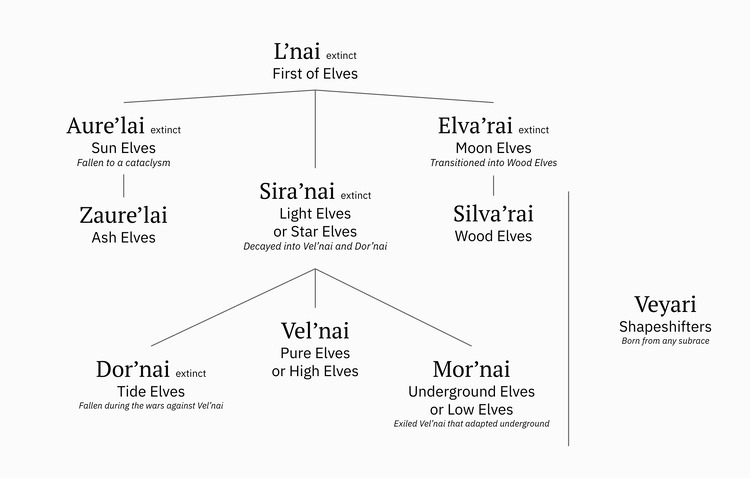First Elves
| First Elf | |
|---|---|
| Major race | |
 Example appearance | |
| Attributes | |
| Average lifespan (max) | 2000 years (3000) |
| Age of maturity | 500 years |
| Height range | 1.75 - 2.20 m (5′9′′ - 7′30′′) |
Parent Race: Elf
Note: The First Elves are considered an extinct race. While their legacy is alive in elf minor races, the First Elves should not be used as a playable race by new characters.
The First Elves, or L’nai, are a mythic and foundational elven lineage believed to be the origin of all other elven races in Alathra. Existing in the ancient age of the world, the L’nai are regarded as the progenitors of the elven condition: long-lived, magically resonant, and intimately bound to the natural and cosmic forces of the world.
Though the L’nai no longer walk the world in their original form, traces of their essence persist in the bloodlines, rituals, and latent magic of their descendants. Their legacy splintered early into three dominant aspects: the Aure’lai (Sun Elves), the Sira’nai (Star Elves), and the Elva’rai (Moon Elves). From these lineages came all other elves, each carrying fragments of the L’nai’s primordial gift.
Some traditions suggest that rare individuals—most notably the Veyari—may still carry the L’nai spark in its raw form, allowing them to shift, adapt, and traverse boundaries between kin.
Etymology
- L’nai: From contraction of two root syllables elun (first, beginning) + nai (essence, bound)—roughly translating to “those of the first breath” or “origin-bound.”
Physical Traits
Descriptions of the L’nai vary widely and are often symbolic:
- Form: Believed to be mutable—tall or slight, luminous or shadowed, depending on mood, purpose, or season.
- Eyes: Said to glow faintly in reflection of the elemental force they were aligned with (sunlight, starlight, moonlight, or shadow).
- Voice: Described in myth as melodic, echoing with multiple tones or harmonics.
- Lifespan: Effectively immortal while undivided. Aging is believed to have only begun after divergence into later lineages.
Elven Lineage
The elves of Alathra trace their origins to the L’nai, the First Elves—primordial beings of long life, arcane potential, and fluid essence. Over the ages, the L’nai gave rise to multiple branches through divergence in philosophy, environment, and magical affinity.
From the L’nai emerged the Aure’lai (Sun Elves), Sira’nai (Star Elves), and Elva’rai (Moon Elves), who formed the three great ancient lineages. Each of these lines would, in time, fragment further into the modern elven subraces of today: the imperial Vel’nai (High Elves), exiled subterranean Mor’nai (Low Elves), extinct seaborne Dor’nai (Tide Elves), forest-bound Silva’rai (Wood Elves), and the remote Zaure’lai (Ash Elves).
Scattered among all lineages are the rare Veyari, shapeshifters born with residual echoes of the L’nai essence. Though rare, they are found across all elven communities and maintain no distinct homeland of their own.

Culture
Littles is known of the L’nai, they are associated with a proto-society rooted in oral memory, elemental communion, and world-harmony rather than hierarchical structure.
They revered forces and astronomical entities. Over time, these philosophical lenses hardened into distinct practices that birthed the ideological divides between their descendant races.
Legacy
The legacy of the L’nai endures not only in the bloodlines of modern elves but in the structure of their societies, rituals, and languages.
- The Veyari, rare individuals born with L’nai spark, are considered sacred by some and feared by others. They alone retain the instinctual shapeshifting traits said to define the L’nai.
- Runes, seasonal rites, and elemental harmonies still bear traces of L’nai culture across elven religions and magic.
- L’nai Names are sometimes invoked during oaths, funerals, or rites of passage to mark the deep lineage of a bloodline.
Though no L’nai is believed to exist today in pure form, all elvenkind carry fragments of their essence. Their disappearance is considered the beginning of elven history and the end of the age of origin.